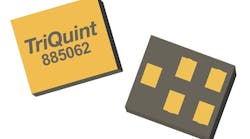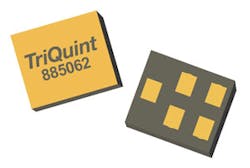A pair of bulk-acoustic-wave (BAW) filters developed by TriQuint for wireless applications at 2.4 GHz—such as Bluetooth and wireless-local-area-network (WLAN) systems—that must coexist with Fourth-Generation (4G) networks is now available from the firm’s stocking distributor, RFMW, Ltd. Models 885062 and 885071 BAW filters pass desired WiFi signals and provide high rejection in adjacent 4G Long-Term-Evolution (LTE) cellular bands while fitting into compact housings measuring just 1.4 × 1.2 × 0.46 mm.
Model 885062 exhibits maximum insertion loss of 1.7 dB in the WiFi passband, with out-of-band rejection of 53 dB from 2300 to 2365 MHz and 58 dB from 2365 to 2370 MHz. Model 885071 has maximum WiFi passband insertion loss of 1.9 dB, with out-of-band rejection of 53 dB from 2300 to 2370 MHz and 55 dB from 2496 to 2501 MHz. Both filters are rated for average power-handling capability to +28 dBm, and both are AEC-Q200 qualified for automotive applications.
RFMW, Ltd. (stocking distributor for TriQuint), 188 Martinvale Lane, San Jose, CA 95119; (408) 414-1450

